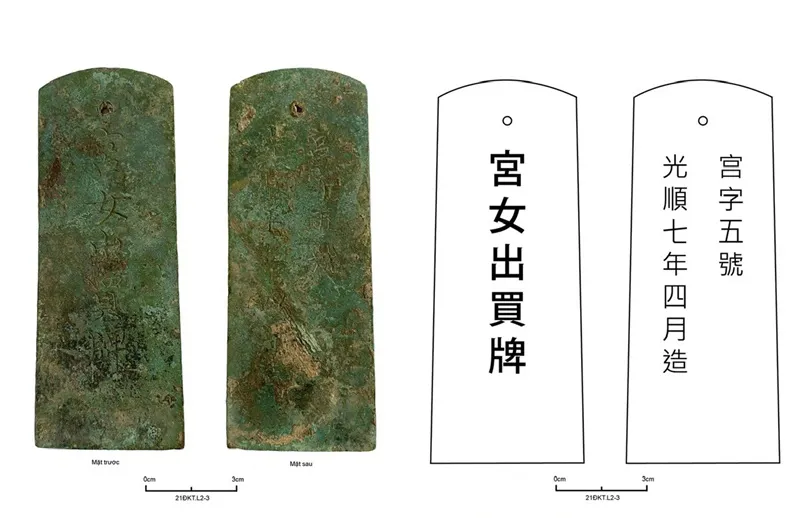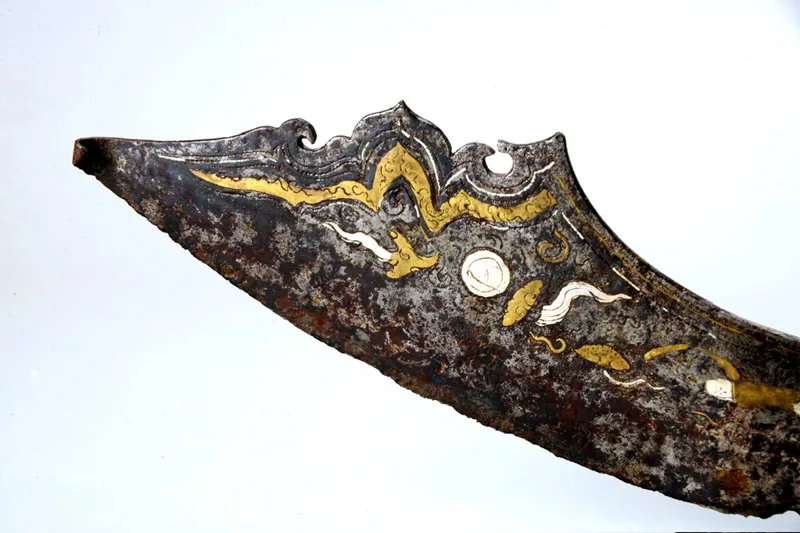The secrets of Vietnam's national treasures revealed
The newly designated "Vietnamese National Treasures" represent the nation's diverse, multi-ethnic and vibrant culture.
Deputy Prime Minister Tran Hong Ha has signed a decree recognizing 29 national treasures, including many precious artifacts dating thousands of years found in major archaeological digs across Vietnam.
| The dedicated image on the front side of the Sao Vang bronze drum. Photo: Dan tri |
According to local experts from the Vietnam National Heritage Council, preservation and promotion are important for cultural heritage and even more so for national treasures. The localities and agencies in charge of the objects have taken this task seriously so that the treasures can be shown to the public.
The Sao Vang or Golden Star Bronze Drum, a representative of the Dong Son culture dating back some 2,000 years, was declared a national treasure on January 18. It belongs to the late Heger type I drums, with a height of 86 cm and a front diameter of 116 cm. It is considered the largest Dong Son bronze drum ever found in the country and is currently kept at the Vietnam National Museum of History.
The drum head bears a 12-pointed star in the center adjacent to concentric bands decorated with N-shaped patterns, double circles, short parallel lines, multi-layered rhomboids, and others. The patterns are common to Dong Son bronze drums of the same period and vividly depict the daily life of ancient Vietnamese people.
| The details of the Sao Vang Bronze Drum's body. |
Daily life scenes on the drumhead include the image of people in costume alternating with four stilt houses with curved roofs. A panel near the rim is decorated with Lac birds, a mythical creature in Vietnamese culture and a national bird of Vietnam, following each other counterclockwise, while the rim is decorated with four toad sculptures, also facing counterclockwise.
The drum body is also decorated with circular patterns and short parallel lines. The drum has two pairs of double handles embossed with flowering rice plants. The underside has no decoration.
Co Loa Temple's dragon figurines, or the pair of stone dragons at the Thuong (Upper) Temple's doorstep, dating from 1732 under the Le dynasty revival and preserved at the Co Loa relic site by the Thang Long - Hanoi Heritage Conservation Center, were recognized as a national treasure on January 18.
| The stone dragon statues on the stairs leading to the upper temple, Co Loa Relic Site on the outskirts of Hanoi. Photo: Di Tich Co Loa |
The dragons were carved on whole blocks of stone, with majestically curved bodies covered with scales all the way to their tails. The two sides of the doorstep have similar structures and decorative patterns and are the only ones associated with a famous relic dedicated to King An Duong Vuong - the founder of the Au Lac State in the 3rd century BC.
The collection of Buddhist text pillars from the Dinh Dynasty in the 10th century, housed in the Ninh Binh Museum, are all made of bluestone, including the base, pedestal, shaft, capital, lotus base, and lotus bud. They were erected vertically using mortise-and-tenon joints instead of glue.
This is the only surviving written historical source from the Dinh Dynasty and the earliest stele inscriptions from the feudal autonomous era ever discovered. They not only record historical events, but also demonstrate the development of writing in the 10th century.
| The Stone pillar carved with Buddhist scriptures found in Ninh Binh Province. Photo: Dan Tri |
The stone stele of Dai Bi Pagoda is a rare and ancient one, which belongs to Dai Bi Pagoda in Lac Dao Commune, Van Lam District, Hung Yen Province. The stele is made of an entire flat bluestone block and was erected in 1327 during the Tran Dynasty. Its top and edges are relatively intact, unlike the lost base.
The stele was entirely carved using traditional hand carving techniques. Its top and side borders are carved with chrysanthemum vines, and the bottom with water waves resembling mountains. A stylized glowing jade symbol stands alone on the top edge of the back, a unique feature that rarely appears on steles of the same period.
The Early Le Dynasty Royal Maids' Access Card is currently kept at the Thang Long - Hanoi Heritage Conservation Center and dates from the fourth month of the 7th Quang Thuan year during the reign of King Le Thanh Tong (i.e., 1466). The pass is a flat, thin, rectangular copper alloy plate with a curved top. Both sides are deeply and clearly engraved with Chinese characters, with the five on the front reading "Royal Maids' Access Pass."
| The royal maids' inner court admission card dates back some thousand years. |
In addition to the pass, the Thang Long - Hanoi Heritage Conservation Center also houses three other items that have also been designated as national treasures this time, namely the Can Tam Khi knife, a terracotta Bodhi leaf with a phoenix motif, and an early Le Dynasty terracotta architectural model.
The Can Tam Khi knife, dating back to the 14th century under the Tran Dynasty, was delicately decorated with various patterns on both sides.
The Ly Dynasty terracotta bodhi leaf with a phoenix motif dates back to the 11th century. With its main body slightly damaged and its pedestal lost, this is the most complete and beautiful version compared to others of the same type that have been discovered.
The early Le Dynasty terracotta architectural model, dated to the 15th century, is the remnant of a completed work, including part of the roof and part of the structural frame.
| The sophisticated details of the weapon under the Tran Dynasty in the 14th century. |
On this occasion, several artifacts of the Cham culture were recognized as national treasures. Among them, three are currently housed in the Danang Museum of Cham Sculpture, namely the My Son E1 Brahma's Birth relief from the 7th or 8th century from My Son Sanctuary, Quang Nam Province; the My Son C1 Shiva statue from the 8th century from My Son Sanctuary, Quang Nam Province; and the Tra Kieu Apsara relief from the 10th century from Tra Kieu Village, Duy Xuyen District, Quang Nam Province.
In particular, the My Son C1 Shiva statue was found in the My Son C1 temple tower and is a life-size statue depicting the physical characteristics of the Cham people: slightly slanted, wide-open eyes, large nasal wings and thick lips, square shoulders, and an upright posture that exudes great strength.
| My Son C1 Shiva Statue. Photo: Da Nang Museum of Cham Sculpture |
| The Statue of My Son E1 Brahma's Birth Relief. Photo: Da Nang Museum of Cham Sculpture |
| The Tra Kieu Apsara relief is on display at the Danang Museum of Cham sculpture. Photo: Da Nang Museum of Cham Sculpture |




.jpg)













